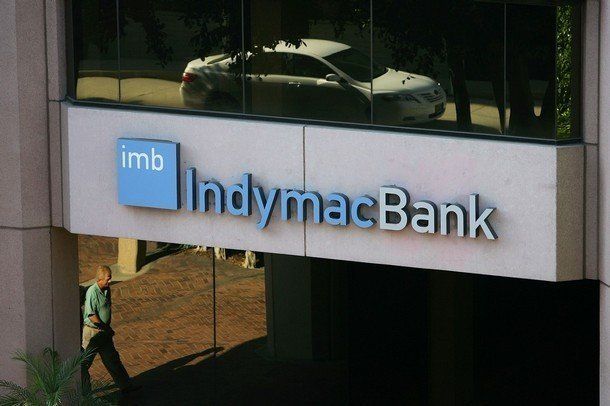
When the federal government first took over IndyMac Bank in July, it estimated that it would cost between four and eight billion dollars to seize it, break it up and sell it back into the market.
If only.
Late on Thursday, the Federal Deposit Insurance Corporation announced that it had completed the sale of IndyMac and sustained a $10.7 billion loss, which doesn't include the roughly $2 billion in shareholder wealth that was wiped out.
The IndyMac scenario isn't necessarily an argument against nationalizing insolvent banks. But it does show that there is no path out of the crisis that is without cost. As President Obama recently told 60 Minutes, his choices are between bad and worse.
IndyMac, when it was seized, estimated its assets at $32 billion. The cost of the takeover -- roughly one third of its value -- indicates that that the depth of the losses on banks' balance sheets are likely even greater than is currently acknowledged.
And it illuminates another potential peril that regulators must grapple with: as the government went about cleaning IndyMac up and reselling it into the private market, according to the FDIC, depositors withdrew money in droves, leading to even greater losses as those deposits needed to be covered.
While the debate rages, regulators continue to take over failed banks. On Friday, federal regulators seized the U.S. Central Federal Credit Union, a giant wholesale credit union with some $34 billion in assets. It also grabbed Western Corporate Federal Credit Union, with $23 billion in assets, and three small banks, bringing the total bank seizures in 2009 to twenty.
Treasury Secretary Tim Geithner has proposed a trillion dollar plan to partner with private investors to rescue the banking system by taking toxic assets off banks' balance sheets. The effort is aimed at avoiding the outright nationalization or failure of major banks. If the plan fails, and the government moves to nationalize, the IndyMac scenario opens a window into what it might look like.
Story continues below
"The main inference to draw is that this particular very low recovery rate does suggest that institutions with similar kinds of mortgages are going to be in similar kinds of trouble," says economist James Galbraith.
David Barr, a spokesman for the FDIC, says that the loss -- equaling a third of the bank's liabilities -- was very large by historical standards.
William Black, a former federal regulator who helped clean up the S&L debacle in the 1980s, said that the cost of rescuing IndyMac dwarfs the previous largest failure in history, Lincoln Savings, which soaked up $3.4 billion.
But it doesn't end there. IndyMac sold tens of billions of dollars worth of mortgages to other banks over the past several years, which it bundled together and sold as safe assets. Given the huge loss suffered by the FDIC in taking over IndyMac, the prognosis for the health of the assets it sold into the market isn't good.
"They were enormously more damaging as a vector," writes Black in an e-mail, saying that in epidemiological terms, the bad loans IndyMac pushed on other banks infected them, too. "Recall that in 2006 alone they sold $80 billion of liar's loans to others. In 2007 they were selling at an even higher rate until the market collapsed. The prior years are also likely to be extremely large. The percentage losses on IndyMac liar's loans are staggering. The combination means that this single S&L is likely to have caused losses roughly equivalent to the cost in 1993 dollars of resolving the entire S&L debacle ($150 billion). At the time, the S&L debacle was widely described as the worst financial scandal in U.S. history."
IndyMac's losses on the "liar loans" were so large, Black suggests, because the loans were awarded fraudulently. The likelihood of fraud is high. Fitch Ratings looked at a small sample of nonprime loans at a different bank in 2007. "The result of the analysis was disconcerting at best, as there was the appearance of fraud or misrepresentation in almost every file," their report finds.
Ratings agencies and regulators assess the strength of loans in a portfolio by examining a sample of them and looking at the underlying documents, known as loan "tapes." Once banks began bundling and selling those loans, the documentation was often separated from the loan. Some raters showed no interest in finding out what was behind a loan.
"Any request for loan level tapes is TOTALLY UNREASONABLE!!! Most investors don't have it and can't provide it. Nevertheless we MUST produce a credit estimate," writes one ratings agency executive in an e-mail that surfaced at a congressional oversight hearing. "It is your responsibility to provide those credit estimates and your responsibility to devise some method for doing so."
Galbraith says that the only way to know whether other banks have been infected is to examine a sample of the loans on their books by looking at the underlying documentation.
"That's the exact kind of question we ought to have an answer to and it'll take a regular investigation to determine it," he says, calling for "an audit, examination of an appropriate sample of the underlying loan tapes to determine just how bad the situation is in light of the cost of resolving IndyMac... That's a good indicator of just how irretrievable a fair number or large share of these instruments are."
It'll take more than Geithner's stress tests, he says, because those exams rely on the bank's word for what mortgages are worth and simply plugs new macroeconomic numbers into the bank's own models.
For Dean Baker, an economist with the liberal-leaning Center for Economic and Policy Research, the IndyMac losses indicate a deeper crisis in the banking system. "It implies there are real big losses there, but those losses are there whether we take them over or not," he says. "It's very likely that we're looking at a larger hole than the administration has been acknowledging and to my mind that argues for a takeover strategy."
If the losses are that large, he says, then the banks are truly insolvent and have an incentive to take huge risks -- perhaps illegal ones -- to get out of the hole.
IndyMac heavily invested in alt-a mortgages, known in the industry as "liar's loans," because no proof was required to back up declarations of income or assets. The bank did much of its business in California, which saw one of the biggest expansions of the bubble and has since seen some of the worst fallout out from the foreclosure crisis.
Baker points out, however, that in the eight months since it was taken over, the economy and real estate market has deteriorated dramatically, so hope that IndyMac was markedly different than other banks would be misplaced.
Extrapolating the IndyMac losses to a larger scale can give insight into the depth of the financial problem. If CitiGroup, for instance, has a one-third-size hole in its balance sheet, then the bank, which has roughly $1.5 trillion in assets, is short about $500 billion. The total mortgage market is roughly $14 trillion.
It's not going to be cheap to plug that hole, a reality both Galbraith and Baker emphasize.
"The lesson to take away from this is that nationalization is not a cheap process," says New Yorker business columnist James Surowiecki, who added that the IndyMac scenario doesn't mean that nationalization is the wrong strategy, only that it will be extremely expensive. "Sometimes the way its talked about in the press or by politicians makes it seem like it's an alternative to continuing to shelling out money. But I think that's a dangerous way to look at it."
In other words, money will be shelled out either way, says Surowiecki. The danger would come, he says, if the federal government nationalized a few banks and Congress decided not to provide the money.
The debate over nationalization has been very short on specifics. The IndyMac example provides some of those. Surowiecki helped the Huffington Post run the traps of the IndyMac balance sheet. The FDIC confirmed the following details.
IndyMac had $19 billion in deposits as of March 31, almost all of that was insured. It also owed the Federal Home Loan Bank $10.1 billion that was backed by IndyMac mortgages. It had north of $2 billion in other debt and preferred stock.
Its liability, then, was about $32 billion. (Deposits are liabilities because the bank owes them to its customers.) So how did the FDIC lose $10.7 billion? Where'd the money go?
As a top debt holder, the FHLB was first in line to get paid back. The FDIC sold some mortgages at a loss, but still owed the FHLB in full, accounting for some of the loss. The FDIC's Barr couldn't break out specific numbers, but by the time the bank was sold on Thursday, the bank's assets, which it had previously listed at $32 billion, were now $23.5 billion. That was a combination of sales and markdowns.
The FDIC sold $20.7 billion of those assets to new investors who created a new bank, OneWest, for the discounted price of $16 billion. The FDIC is holding on to the rest of the assets to sell later. Those assets, combined with the $16 billion, gave the FDIC about $19 billion to pay off the $32 billion worth of liabilities. That's a roughly $13 billion gap.
The shareholders were wiped out instead of paid back. The creditors, other than the FHLB, have yet to be paid back and may or may not be, says Barr. And uninsured depositors were paid back at a 50 percent rate. (The depositors may end up getting more.) Those three moves reduced the FDIC's loss to $10.7 billion.
Depositors didn't all stick around to see how things worked out. A year ago, the bank was sitting on those $19 billion in deposits. When it was finally sold last Thursday, that number had fallen to $6.4 billion. About half of those were brokered deposits that were run off. "The FDIC provided a line of credit to the bank," says Barr. "Basically, running off those high-cost deposits and replacing it with a loan from the FDIC. A chunk of that loan is still with the bank, and the new owners must repay the balance."
The other $6 billion was pulled out just before and after the bank was seized. Sen. Charles Schumer (D-N.Y.) sent a letter to regulators questioning the viability of IndyMac in July. Over the next 11 days, depositors pulled out $1.3 billion in a run on the bank, forcing the takeover. But the bank still declared about $19 billion in deposits when it was seized, meaning the run didn't stop after the closure.
"Aside from the way it demonstrates that nationalization is not a cheap process, the one thing that I think is most interesting about the IndyMac numbers is how much its deposits shrank after it was taken over," says Surowiecki. "Some people have argued that as long as it was clear that the government was in charge of, say, Bank of America, that people wouldn't pull their money out. But the IndyMac story suggests that's probably not true."
UPDATE: A reader makes an interesting point about the subsequent increase to the FDIC limit for insured deposits, which has been bumped up from $100,000: "Re: IndyMac's shrinking deposits: the bank was nationalized before the FDIC bumped its protection up to $250,000. People were also nervous b/c that was one of the first big failures to take place, and they had no idea what would happen to their money."
